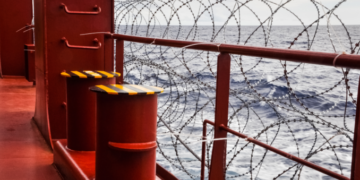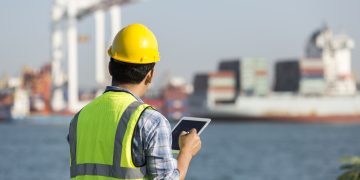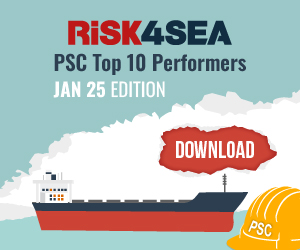Governments are expected to close in on key shipping climate laws–including a global carbon price–at the Intersessional Working Group on Reduction of GHG Emissions from Ships (ISWG-GHG 18), on 17-21 February in London.
As explained, there is huge political momentum for a shipping levy to be adopted at the IMO in 2025, which would be the world’s first universal fee on any international polluter. Over 50 countries from Europe, Africa, Asia, the Pacific and the Caribbean support this mechanism at the IMO, representing a majority of the world’s fleet.
We believe that the levy proposal, that is now supported by governments responsible for a large majority of the world’s shipping tonnage, as well as by the global shipping industry, provides the best and most pragmatic means of decarbonising shipping at speed and scale.
… said the Secretary General of the International Chamber of Shipping, Guy Platten, ahead of the ISWG-GHG 18.
Forty-eight countries, the European Commission, and the industry (through the International Chamber of Shipping) specified that the future levy price should be within the price range of $18-150 per tonne of greenhouse gas, ahead of the February meeting.
We hope to hear more countries champion a universal price, in particular, calling for a high starting price and revenues to be distributed in a way that’s just and equitable, and leaves no one behind.
… said Blánaid Sheeran, Policy Officer, Climate Diplomacy, Opportunity Green
Carbon pricing on shipping is a tool to help close the price gap between fossil fuels and renewable energy, and generate revenues for an equitable transition. A study by UNCTAD, commissioned by the IMO, found that a levy of $150-300/tonne of greenhouse gas, if designed correctly, is the best way to lower the economic impacts of shipping decarbonisation on global GDP growth, and to promote global economic equality.
Key findings from recent reports on IMO’s shipping decarbonization plans:
-
UCL Report on Proposed Policy Measures:
- The debate within the IMO has narrowed to two main approaches: one supporting a Global Fuel Standard (GFS) with a carbon levy, and the other favoring GFS with a credit trading system but without a carbon price.
- 70% of global shipping tonnage now backs the GFS + carbon levy approach, which is vital for shaping the outcome of upcoming negotiations.
- The primary challenges involve understanding the technical and economic aspects of these measures, and crucial questions about who will bear the costs and who will benefit from the new policies.
-
UCL & IDDRI Report on Impact to Vulnerable Countries (LDCs and SIDS):
- The mid-term measures being discussed by the IMO could raise transport costs, disproportionately affecting Least Developed Countries (LDCs) and Small Island Developing States (SIDS), with potential risks to food security.
- Countries like Papua New Guinea, Haiti, and Yemen are particularly vulnerable to the impacts of these cost increases.
- Restricting the use of revenues to shipping-related investments may not adequately address these countries’ needs, suggesting that broader revenue distribution is necessary to mitigate risks to food security and other sectors.
-
Namibia & Malawi Report on African Economic Impacts:
- Many policy scenarios could lead to GDP declines in African countries compared to a “business-as-usual” scenario. However, scenarios that include both a high carbon levy and revenue distribution show potential GDP growth in some countries.
- Price increases across various policy scenarios could worsen inflation, particularly in African nations.
- Proper revenue distribution is crucial to help mitigate the economic challenges posed by higher transport costs due to decarbonization policies.
-
UCL & UMAS Study on E-Fuel Transition:
- Combining high carbon prices with targeted e-fuel subsidies is essential to make zero-emission fuels competitive with other options like LNG, biofuels, and CCS.
- A GFS with a flexibility mechanism might not initiate a transition to scalable e-fuels before 2040, indicating that stronger incentives are needed for an earlier shift to cleaner fuels.
In summary, while the shipping industry is progressing toward decarbonization, the success of these measures hinges on equitable revenue distribution and policies that support vulnerable countries, especially in Africa and the most at-risk SIDS and LDCs.
To build a more ocean-friendly shipping industry, member states must ensure that both the fuel standard and levy align with the concurrent IMO revision of its Carbon Intensity Indicator, which is intended to advance more efficient and less GHG-intensive shipping
… commented Delaine McCullough, Shipping Emissions Policy Manager at Ocean Conservancy and President of the Clean Shipping Coalition.
The policy is negotiated as part of a ‘basket’ of various measures, as an ‘economic measure’, intended to deliver agreed emission cuts in an equitable way: 30% by 2030, 80% by 2040, to reach zero by 2050. The basket also includes a global fuel standard (GFS), a ‘technical measure’, aimed at driving up the use of zero-emission energy on ships to effectively fully power the sector by 2050.
Anais Rios, Shipping Policy Officer, Seas At Risk, explained that striving for a high levy must unlock investments to uptake wind propulsion technology – harnessing the only true zero-emitting fuel that is readily available at the high seas: wind. Meanwhile, Ambassador Albon Ishoda, Marshall Islands Special Envoy for Maritime Decarbonization, said that the debate is no longer about whether a levy is needed—it is about ensuring it is strong enough to be effective.
The revenues from this levy must be directed toward those on the frontlines—the nations facing existential threats due to emissions they did not create. Anything less is immoral and unacceptable. The time for bold and decisive action is now
… noted Simon Kofe, Tuvalu Minister for Transport, Energy, Communication and Innovation.


































































